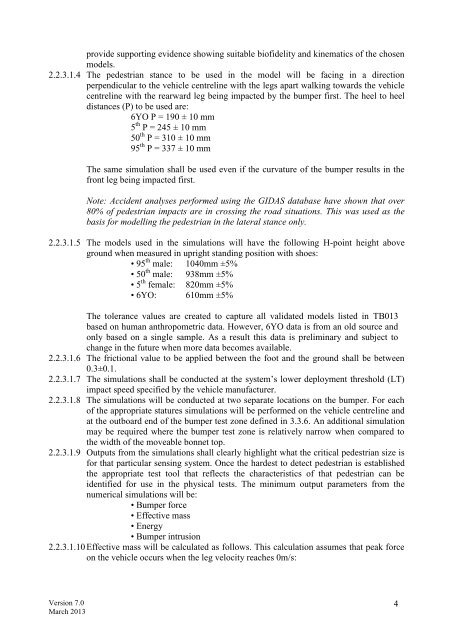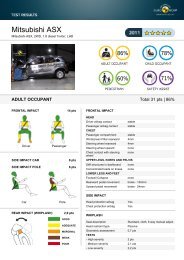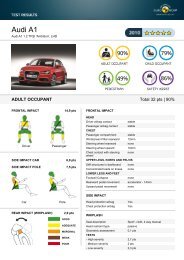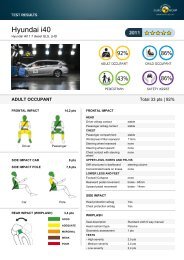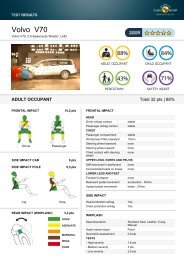Pedestrian Test Protocol - Euro NCAP
Pedestrian Test Protocol - Euro NCAP
Pedestrian Test Protocol - Euro NCAP
You also want an ePaper? Increase the reach of your titles
YUMPU automatically turns print PDFs into web optimized ePapers that Google loves.
provide supporting evidence showing suitable biofidelity and kinematics of the chosen<br />
models.<br />
2.2.3.1.4 The pedestrian stance to be used in the model will be facing in a direction<br />
perpendicular to the vehicle centreline with the legs apart walking towards the vehicle<br />
centreline with the rearward leg being impacted by the bumper first. The heel to heel<br />
distances (P) to be used are:<br />
6YO P = 190 ± 10 mm<br />
5 th P = 245 ± 10 mm<br />
50 th P = 310 ± 10 mm<br />
95 th P = 337 ± 10 mm<br />
Version 7.0<br />
March 2013<br />
The same simulation shall be used even if the curvature of the bumper results in the<br />
front leg being impacted first.<br />
Note: Accident analyses performed using the GIDAS database have shown that over<br />
80% of pedestrian impacts are in crossing the road situations. This was used as the<br />
basis for modelling the pedestrian in the lateral stance only.<br />
2.2.3.1.5 The models used in the simulations will have the following H-point height above<br />
ground when measured in upright standing position with shoes:<br />
• 95 th male: 1040mm ±5%<br />
• 50 th male: 938mm ±5%<br />
• 5 th female: 820mm ±5%<br />
• 6YO: 610mm ±5%<br />
The tolerance values are created to capture all validated models listed in TB013<br />
based on human anthropometric data. However, 6YO data is from an old source and<br />
only based on a single sample. As a result this data is preliminary and subject to<br />
change in the future when more data becomes available.<br />
2.2.3.1.6 The frictional value to be applied between the foot and the ground shall be between<br />
0.3±0.1.<br />
2.2.3.1.7 The simulations shall be conducted at the system’s lower deployment threshold (LT)<br />
impact speed specified by the vehicle manufacturer.<br />
2.2.3.1.8 The simulations will be conducted at two separate locations on the bumper. For each<br />
of the appropriate statures simulations will be performed on the vehicle centreline and<br />
at the outboard end of the bumper test zone defined in 3.3.6. An additional simulation<br />
may be required where the bumper test zone is relatively narrow when compared to<br />
the width of the moveable bonnet top.<br />
2.2.3.1.9 Outputs from the simulations shall clearly highlight what the critical pedestrian size is<br />
for that particular sensing system. Once the hardest to detect pedestrian is established<br />
the appropriate test tool that reflects the characteristics of that pedestrian can be<br />
identified for use in the physical tests. The minimum output parameters from the<br />
numerical simulations will be:<br />
• Bumper force<br />
• Effective mass<br />
• Energy<br />
• Bumper intrusion<br />
2.2.3.1.10 Effective mass will be calculated as follows. This calculation assumes that peak force<br />
on the vehicle occurs when the leg velocity reaches 0m/s:<br />
4


